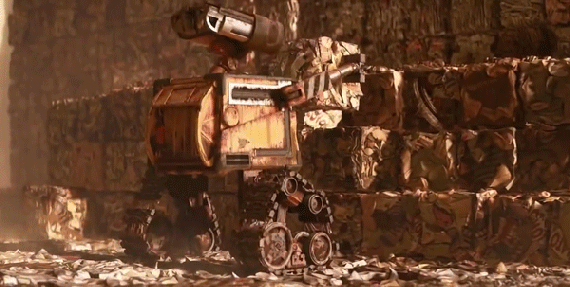Ten years later, what we learned from WALL-E
“It's a wicked satire of American consumerism and of environmental degradation, but it also has this cheerful little character," according to sci-fi writer Kim Stanley Robinson.

Ten years ago this summer, we all became familiar with the little trash compacter that could — WALL-E — and his slightly scary, Earth-scanning, but eventual companion Eve.
Disney’s “WALL-E,” which took home the Academy Award for Best Animated Picture in 2009, offered a darker look at Earth’s possible future — one where humans have ruined the planet’s environment with trash — and are forced to live in space, captive to screens, self-driving chairs and robot servants.
As a part of our summer entertainment series, we’re pondering the critiques and lessons of “WALL-E” with Hugo award-winning, science-fiction writer Kim Stanley Robinson, most notable for his Mars trilogy, a series of books all about the terraforming and subsequent settlement of the planet Mars.
Marketplace Tech host Molly Wood sat down with Robinson to discuss the real-life implications of issues brought up in the film, and how some of the critiques it made about society 10 years ago are still relevant now.
Environmentalism

WALL-E depicts an Earth in squalor, completely covered in trash left behind by its former human inhabitants.
Director Andrew Stanton may have denied the movie’s environmentalist message at the time, but the film on its own arguably showcased our planet’s growing problems with pollution and waste.
“There is a worldwide awareness of climate change and of environmental collapse, and that was also true in 2008,” Robinson said.
But despite the degraded conditions WALL-E found himself in, the movie still showed viewers there was potential for reform.
“There’s still one little sprig of a plant that WALL-E finds and realizes is different, as does Eve. So there’s the possibility of regeneration and of restoration that where there’s life, there’s hope,” Robinson noted.
Robinson points to the creation of the Paris Agreement — a worldwide pact to reduce carbon emissions — as evidence that society has pushed for change on this issue.
Lifestyle and consumption

The concept of convenience very much takes the front seat throughout the latter half of “WALL-E” when it is revealed that humanity is still alive and kicking, though restricted to self-driving chairs.
As Robinson explains, humans in the film “are essentially like infants.”
“They can’t even move. They have to be fed. They’re being fed too much,” Robinson said. “They’ve got a ton of baby fat, and so adulthood has been taken away.”
That struck a nerve when Robinson watched the film for the first time.
“It was middle America on a summer vacation … in a theater where you got to eat pizza while you watch the movie … and we were sitting back in recliners,” he said. “It’s one of the very few satires that I think pokes a needle right into the heart of our lifestyle.”
Jobs and the modern economy

The film also arguably commented on the menial work that employees have to deal with.
“WALL-E looks like Sisyphus. He’s a worker bee,” Robinson said. “He has a stupid job to package trash into giant skyscraper like columns. It’s pointless in a way, and he’s just beavering away at it.”
Authors like David Graeber (writer of the book “Bullshit Jobs: A Theory”) have started to point how many of our jobs are meaningless. In the U.K., nearly 40 percent of workers said they were quite sure that their jobs made no significant contribution to the world at all.
However, like many of the other themes in the film, “WALL-E” shows how the characters can upend the circumstances they’ve been placed in.
“[WALL-E] begins to make all kinds of mature adult decisions. He falls in love, does radical things, joins a revolution and overthrows the social order that already exists,” Robinson said.

Click the above audio player to hear the full interview with Kim Stanley Robinson.












